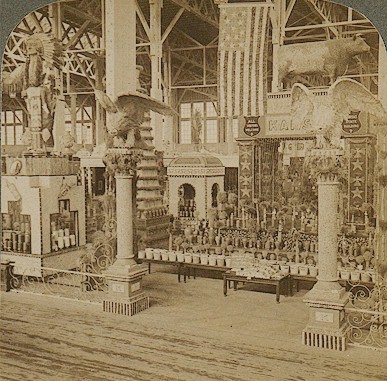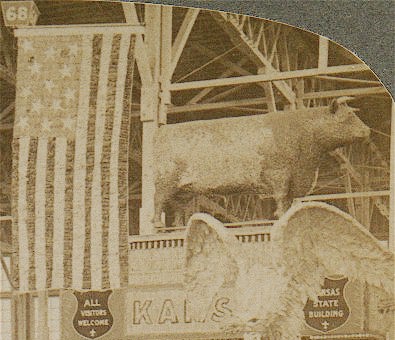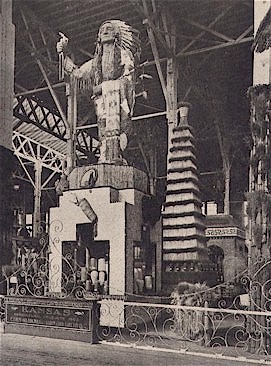
|
Agricultural History Series |
Missouri State University |
1904 St. Louis Worlds Fair
Block 68 - Kansas
The Kansas Display featured Wheat and other grains grown in Kansas. H. H. Kern, was Superintendent of the Kansas Exhibit and he wrote the following report that was published in the "Report of the Kansas World's Fair Commission":
The Kansas Pavilion in the Agricultural Palace occupied a space assigned to Kansas, north and south 92 feet, east and west 62 feet, space 68, on the main aisle near the center of the building. Around the pavilion was a scroll-iron fence covered with chains of cane links festooned from pillar to pillar On each side were four pillars, 16 feet high, decorated with ears of corn and corn-husks. Upon each of these rested a Grecian vase made of corn-husks and festooned with rosettes and garlands of com-husks, being one of the most attractive, complete and instructive booths, with a view of showing her numerous products to the best advantage.
Every design had a meaning, representing all the- products of the State. The noted Kansas corn-steer, eagles, colossal Indian, decorating of the outside of the four booths with artistically arranged corn-.husks, the globe, cornucopia, and Cupid, were designed and executed by Mr. 0. H. Kassebaum, of Atchison. The decorations were unique and artistic, and entirely different from any otiier exhibit. The figures were new in design, novel and attractive, and the workmanship of the artists constructed entirely of the numerous grains, grasses and cereals of the State, including nearly every product grown on the fertile fields of the State.

Standing at the main entrance between the two high corn columns rested two eagles with wings spread for flight, one made of corn-husks and kernels of corn, the other made of wheat-straw and kernels of corn, were the work of an artist, and the best pieces of workmanship in their line exhibited at this or any other exposition.
Suspended above and between the two eagles was a 14-foot American flag, a most artistic conception, the stars and stripes made of corn-husk?; dyed red, white and blue, made by the Atchison County High School girls. At the south entrance of the pavilion stood an obelisk pyramid made of wheat-heads towering BO feet high, upon which rested a large sheaf of wheat, 6 feet high, the base standing 6 feet high, and at the top of base was inscribed in wheat-heads, " Kansas, the Banner Wheat State."

The Kansas Block.
One of the most striking features one noticed was the large center pyramid surmounted by a monster steer of the Hereford type, 7 feet in height, fashioned of red and white shelled corn. At the top of this pyramid the, word:" Kansas " was worked in corn. The four large columns supporting the steer were built of plain pine boards, covered with red cloth; this made an excellent background, and showed to advantage the various grain and grass decorations of stars and maltese crosses. Above the pedestal of the center booth was an open pavilion, containing a large bouquet of native tame and ornamental grasses; around this on the four sides were placed large glass jars filled with wheat, oats, barley, rye, flax, grass seeds, etc. Sheaves of wheat, rye, oats, barley, millet, tame and ornamental grasses tied with ribbons were conspicuous over the various glass jars of seeds and grasses.

Kansas Display Enlargement
The four portieres made of various colors of corn kernels, draped from the top to the bottom of the pavilion. Around the base on four sides were grains and grasses in sheaves of every description fastened upon the walls. Just above the base a shelf two feet high contained grains, grasses, field and garden seeds in glass jars, each jar and sheaf having a label giving the name of the exhibit, name and address of grower, the yield per acre, and the test weight.
In each corner of the exhibit stood a booth. On No. 1, in the southeast corner, towered a gigantic Indian fifteen feet high, his face and hands made of plaster of Paris, covered with shelled popcorn, his Navajo blanket, a piece of fine workmanship in woven corn-husks, his feathers made of corn-husks, his quiver of cornhusks, his shield of various beautiful-colored corn, - all showing what can be achieved with kernels of corn and cornhusks, this being the only material used. The top of this was finished with cornstalks; the base was covered with plaited cornhusks; each booth contained four windows. The windows of this booth were square, and finished with rows of red and white corn. Above the windows was -one mass of ears of red, yellow and white corn. In the northeast corner of the exhibit stood booth No. 2, the base being covered with wheat-straw; over this, links of red corn. The center portion of the booth was covered with wheat-straw blocked in corn-stalks. There were four arched windows in this booth finished with rows of white, red and yellow corn. This booth was surmounted by a large globe and a cornucopia of Plenty, from which showers of wheat continually fell on the, earth of wheat, signifying that Kansas supplies the world with wheat.

In the southwest, corner of the exhibit was booth No. 3, covered with pointed puffed corn-husks, a very beautiful design; the base was covered with corn-husks, block-work trimmed with ears of corn, with four arched windows of ear-corn. This booth was surmounted by a large terra-cotta vase filled with a bouquet of native and ornamental grasses.
In the northwest corner stood booth No. 4; the lower base was wheat-straw trimmed with red corn; four large columns covered with corn-husks resembling oval-shaped shingles, top decorated with ear and shelled pop-corn festooned in corn-husks and corn-husk ribbons.
In the center of each booth was a pyramid covered with red cloth, with shelves. On the shelves extending around the pyra- mid were placed glass jars containing wheat, corn, oats, barley, flax, buckwheat, clover, alfalfa and timothy seeds; they repre- sented the best of each kind that could be found, each having been tested before being placed on exhibition.
There were four large pillars on the east side and four on the west side of the center pavilion, 16 feet high and 4 feet wide, covered with green cloth as a background; The exhibits of grain grasses, cane, corn-stalks, Kaffir corn and alfalfa were tied with red and blue silk ribbons and fastened in their position,—each side containing a different kind of grain or grass or other cereal in sheaves.
The background of green, and the grains and grasses tied with blue and red silk ribbons, made a very harmonious effect. At the north entrance stood-a pyramid of native grasses, upon which a vase made of oat-heads, seven feet high, rested. Directly opposite stood a pyramid of tame grasses, upon which rested a vase made of the heads of grains and grasses, seven feet high.
On the south entrance stood two pyramids of different kinds of grains, wheat, barley, flax, speltz, rye, and oats. Upon one of these rested a column of oats twelve feet high; upon the other a column of wheat. These pyramids were covered with a red cloth for background, each sheaf trimmed with blue ribbon. Midway between the central pyramid and the entrance on the east, west and north sides stood twenty tables on which were field and garden seeds, and 150 exhibits of numerous varieties of corn.
The Kansas State Agricultural College, at Manhattan, exhibited alfalfa, corn, cane, Kaffir corn, oats, buffalograss, and big bluestem grass, showing the plant and root growth. Besides these, twenty-five varieties of wheat-sheaves, ten varieties of cane, fourteen feet in length; four varieties of Kaffir corn; three of broom-corn, fifteen feet; and stalks of corn, sixteen feet high; millet, six feet.
State Agricultural College Experiment Station, Hays, Kan., collection of wheat, rye, barley, speltz, oats, flax.
Reference: H. H. Kern, "Report of the Kansas World's Fair Commission". 1905/
Photo::from the collection of Lyndon Irwin.
This page is maintained by Lyndon Irwin.